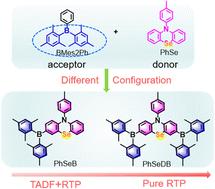当前位置:
X-MOL 学术
›
Chem. Sci.
›
论文详情
Our official English website, www.x-mol.net, welcomes your feedback! (Note: you will need to create a separate account there.)
Achieving pure room temperature phosphorescence (RTP) in phenoselenazine-based organic emitters through synergism among heavy atom effect, enhanced n → π* transitions and magnified electron coupling by the A–D–A molecular configuration
Chemical Science ( IF 8.4 ) Pub Date : 2024-05-02 , DOI: 10.1039/d4sc01200c Daokun Zhong 1 , Siqi Liu 1 , Ling Yue 1 , Zhao Feng 1 , Hongyan Wang 1 , Peng Yang 1 , Bochao Su 1 , Xiaolong Yang 1 , Yuanhui Sun 1 , Guijiang Zhou 1
Chemical Science ( IF 8.4 ) Pub Date : 2024-05-02 , DOI: 10.1039/d4sc01200c Daokun Zhong 1 , Siqi Liu 1 , Ling Yue 1 , Zhao Feng 1 , Hongyan Wang 1 , Peng Yang 1 , Bochao Su 1 , Xiaolong Yang 1 , Yuanhui Sun 1 , Guijiang Zhou 1
Affiliation

|
The weak spin–orbit coupling (SOC) in metal-free organic molecules poses a challenge in achieving phosphorescence emission. To attain pure phosphorescence in RTP organic emitters, a promising molecular design concept has been proposed. This involves incorporating n → π* transitions and leveraging the heavy atomic effect within the spin–orbit charge transfer-induced intersystem crossing (SOCT-ISC) mechanism of bipolar molecules. Following this design concept, two bipolar metal-free organic molecules (PhSeB and PhSeDB) with donor–acceptor (D–A) and acceptor–donor–acceptor (A–D–A) configurations have been synthesized. When the molecular configuration changes from D–A to A–D–A, PhSeDB exhibits stronger electron coupling and n → π* transitions, which can further enhance the spin–orbit coupling (SOC) together with the heave atom effect from the selenium atom. By the advanced synergism among enhanced n → π* transitions, heavy atom effect and magnified electron coupling to efficiently promote phosphorescence emission, PhSeDB can achieve pure RTP emission in both the solution and doped solid film. Thanks to the higher spin–orbit coupling matrix elements (SOCMEs) for T1 ↔ S0, PhSeDB attains the highest phosphorescence quantum yield (ca. 0.78) among all the RTP organic emitters reported. Consequently, the purely organic phosphorescent light-emitting diodes (POPLEDs) based on PhSeDB achieve the highest external quantum efficiencies of 18.2% and luminance of 3000 cd m−2. These encouraging results underscore the significant potential of this innovative molecular design concept for highly efficient POPLEDs.
中文翻译:

通过重原子效应、增强的n→π*跃迁和A-D-A分子构型放大的电子耦合之间的协同作用,在酚硒嗪基有机发射体中实现纯室温磷光(RTP)
无金属有机分子中的弱自旋轨道耦合(SOC)对实现磷光发射提出了挑战。为了在 RTP 有机发射体中获得纯磷光,人们提出了一种有前途的分子设计概念。这涉及到结合 n → π* 跃迁并利用双极分子自旋轨道电荷转移诱导的系间跨越 (SOCT-ISC) 机制中的重原子效应。按照这一设计理念,合成了两种具有供体-受体(D-A)和受体-供体-受体(A-D-A)构型的双极性无金属有机分子(PhSeB和PhSeDB)。当分子构型从D-A变为A-D-A时,PhSeDB表现出更强的电子耦合和n→π*跃迁,可以进一步增强自旋轨道耦合(SOC)以及来自硒原子的举原子效应。通过增强的n→π*跃迁、重原子效应和放大电子耦合之间的先进协同作用,有效促进磷光发射,PhSeDB可以在溶液和掺杂固体薄膜中实现纯RTP发射。由于 T 1 ↔ S 0 具有更高的自旋轨道耦合矩阵元素(SOCME),PhSeDB 在所有 RTP 有机发光体中获得了最高的磷光量子产率(约 0.78)报道称。因此,基于PhSeDB的纯有机磷光发光二极管(POPLED)实现了18.2%的最高外量子效率和3000 cd m −2 的亮度。这些令人鼓舞的结果强调了这种创新分子设计概念对于高效 POPLED 的巨大潜力。
更新日期:2024-05-02
中文翻译:

通过重原子效应、增强的n→π*跃迁和A-D-A分子构型放大的电子耦合之间的协同作用,在酚硒嗪基有机发射体中实现纯室温磷光(RTP)
无金属有机分子中的弱自旋轨道耦合(SOC)对实现磷光发射提出了挑战。为了在 RTP 有机发射体中获得纯磷光,人们提出了一种有前途的分子设计概念。这涉及到结合 n → π* 跃迁并利用双极分子自旋轨道电荷转移诱导的系间跨越 (SOCT-ISC) 机制中的重原子效应。按照这一设计理念,合成了两种具有供体-受体(D-A)和受体-供体-受体(A-D-A)构型的双极性无金属有机分子(PhSeB和PhSeDB)。当分子构型从D-A变为A-D-A时,PhSeDB表现出更强的电子耦合和n→π*跃迁,可以进一步增强自旋轨道耦合(SOC)以及来自硒原子的举原子效应。通过增强的n→π*跃迁、重原子效应和放大电子耦合之间的先进协同作用,有效促进磷光发射,PhSeDB可以在溶液和掺杂固体薄膜中实现纯RTP发射。由于 T 1 ↔ S 0 具有更高的自旋轨道耦合矩阵元素(SOCME),PhSeDB 在所有 RTP 有机发光体中获得了最高的磷光量子产率(约 0.78)报道称。因此,基于PhSeDB的纯有机磷光发光二极管(POPLED)实现了18.2%的最高外量子效率和3000 cd m −2 的亮度。这些令人鼓舞的结果强调了这种创新分子设计概念对于高效 POPLED 的巨大潜力。






























 京公网安备 11010802027423号
京公网安备 11010802027423号